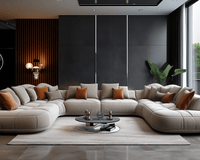1. Introduction
In the realm of interior design, sideboards stand as both functional marvels and artistic statements, weaving seamlessly into the fabric of a well-appointed space. Often known as buffets or credenzas, these pieces of furniture transcend mere storage; they encapsulate a blend of utility and elegance, becoming focal points that elevate the aesthetics of a room while offering unparalleled functionality.
At its core, a sideboard embodies sophistication and versatility. With a flat top surface perfect for showcasing family heirlooms, floral arrangements, or serving platters during gatherings, it effortlessly merges style with practicality. Yet, its allure extends beyond aesthetics. Behind its elegant façade lies a treasure trove of storage, housing dinnerware, linens, and cherished possessions, all while adding a touch of panache to any space.
This comprehensive guide aims to unravel the essence of sideboards, delving into their definition, historical significance, varied functionalities, and enduring charm. Join us on this journey as we navigate through the world of sideboards, discovering their multifaceted role in shaping interiors and their timeless appeal that transcends trends and eras.

2. Defining Sideboards
A sideboard, also known as a buffet or credenza, stands as a quintessential piece of furniture that embodies a harmonious blend of style and functionality. Its defining characteristics lie in its structure, which typically includes a long, low-profile design, offering a flat top surface complemented by an array of storage options underneath.
The top surface of a sideboard serves as a versatile platform. It acts as a stage for displaying decorative items, such as art pieces, vases, or family photos, lending a touch of personal charm to the living space. Moreover, during gatherings or dinners, this expansive surface accommodates serving dishes, making it a convenient area for setting up food or drinks.
Beneath its elegant façade, a sideboard hosts an array of storage compartments. These often include drawers, shelves, or cabinets, providing ample space to organize a variety of items, from dining essentials like cutlery, crockery, and table linens to personal belongings or media equipment in a living room setting.
The versatility of sideboards extends beyond their functionality. They serve as statement pieces that effortlessly integrate into diverse interior design themes. Whether showcasing a classic, ornate style or boasting a sleek, minimalist aesthetic, sideboards enhance the ambiance of any room while offering practical storage solutions.
Moreover, sideboards are strategically positioned within living spaces, frequently gracing dining rooms, living rooms, hallways, or even home offices, adding both visual appeal and organizational efficiency to the environment.

3. Design and Structure of Sideboards
Sideboards exhibit a diverse range of designs and structural elements that contribute to their versatility and appeal within interior spaces. Their design typically comprises a long, low-profile frame that exudes elegance and functionality simultaneously.
Structure:
A sideboard's structure often consists of sturdy, well-crafted wood, although contemporary designs may incorporate various materials like metal, glass, or even a blend of materials. The foundational frame provides stability and support, ensuring longevity.
Storage Features:
Beneath the flat top surface, sideboards offer multifaceted storage options. Some models feature drawers, offering compartmentalized spaces for organizing smaller items. Others boast cabinets or shelves, providing ample room for larger dining essentials, fine dinnerware, or even personal belongings. The variations in storage allow for customization, catering to diverse storage needs and preferences.
Design Elements:
Sideboards are characterized by their ornate details or minimalist aesthetics. Traditional designs may include intricate carvings, embellishments, or ornamental handles, invoking a classic and timeless charm. In contrast, modern iterations often focus on sleek lines, clean finishes, and minimalist hardware, aligning seamlessly with contemporary interior styles.
Versatility in Use:
Their adaptable design allows sideboards to serve multiple purposes across different spaces. In dining rooms, they function as serving stations or display surfaces for fine china, while in living areas, they offer storage for books, media equipment, or serve as stylish consoles for decor display.
Placement and Integration:
Strategically positioned against walls, sideboards blend effortlessly into various settings, becoming focal points that complement the existing decor. Their adaptable designs make them versatile enough to fit harmoniously within diverse interior styles, be it traditional, contemporary, or eclectic.

4. Practical Uses of Sideboards
In Dining Rooms:
One of the primary purposes of a sideboard is its role in dining spaces. Positioned strategically against a wall, sideboards serve as functional companions during meals. Their flat top surface provides an ideal platform for setting up serving platters, drinks, or dessert displays, enhancing the dining experience during gatherings or dinner parties. Moreover, the storage compartments underneath offer convenient access to cutlery, table linens, or additional crockery, ensuring easy organization and accessibility during meal times.
Storage Solutions:
Sideboards act as efficient storage solutions across various living areas. In living rooms or lounges, they accommodate an assortment of items, from board games and magazines to media equipment, allowing for a clutter-free environment while providing a designated space for essential belongings. Additionally, in hallways or entryways, sideboards become convenient drop zones for keys, mail, and other daily essentials, fostering an organized and welcoming entry to the home.
Decorative Displays:
Beyond their functional aspects, sideboards serve as decorative showcases. Their flat surfaces provide opportunities to curate stunning displays, featuring art pieces, family photographs, potted plants, or statement décor items. This integration of function and style adds a personalized touch to the space, elevating its visual appeal while reflecting the homeowner's unique taste and personality.
Versatile Utility:
The adaptability of sideboards extends to home offices or workspaces, where they facilitate organization by storing documents, stationery, or serving as a base for office equipment. Their versatility in catering to varied needs across different rooms makes them indispensable elements in modern homes, providing both style and practicality.

5. Styles and Aesthetics of Sideboards
Classic Elegance:
Classic sideboards often exude timeless elegance through their ornate designs. Crafted from rich, solid woods like mahogany or oak, they boast intricate carvings, decorative details, and traditional hardware. These pieces evoke a sense of grandeur, ideal for homes with a vintage or formal aesthetic.
Modern Simplicity:
Contrasting the ornate styles, modern sideboards embrace sleek lines, minimalist forms, and clean finishes. Often crafted from materials like glass, metal, or lacquered wood, they radiate simplicity and sophistication. Their minimalist allure suits contemporary interiors, offering a chic and uncluttered look.
Rustic Charm:
Sideboards with rustic aesthetics celebrate natural elements and a laid-back ambiance. Crafted from reclaimed wood or showcasing distressed finishes, they exude a cozy, lived-in charm. Rustic sideboards often feature earthy tones, raw textures, and natural imperfections, perfect for country-style or eclectic homes.
Transitional Fusion:
Transitional sideboards strike a balance between classic and contemporary styles. They blend elements from both worlds, featuring clean lines with subtle ornamental touches or traditional shapes with modern finishes. These versatile pieces seamlessly integrate into diverse interior styles, offering a transitional aesthetic.
Scandinavian Influence:
Sideboards inspired by Scandinavian design principles emphasize functionality, minimalism, and craftsmanship. Characterized by clean lines, light wood tones, and functionality-driven designs, they prioritize simplicity and functionality while exuding a sense of understated elegance.
Eclectic and Unique:
For those seeking one-of-a-kind pieces, eclectic sideboards offer a blend of diverse styles, materials, and finishes. These unconventional designs showcase creativity and individuality, making them statement pieces that add character to any room.

6. Historical Evolution of Sideboards
Origins in the Renaissance:
The genesis of sideboards can be traced back to the late Renaissance period in Europe. Initially, these furniture pieces were movable serving tables placed at the side of the dining hall. They primarily held elaborate spreads of dishes, showcasing the host's wealth and status.
18th and 19th Centuries:
The 18th and 19th centuries witnessed the evolution of sideboards into more refined and standalone furniture items. Influenced by the Georgian and Victorian eras, sideboards became larger and more decorative. They were often crafted from exquisite woods like mahogany or walnut, showcasing intricate carvings and ornamental details that symbolized opulence and social standing.
Functional Adaptations:
As the function of sideboards expanded, incorporating storage options like drawers, cabinets, and shelves, their design adapted accordingly. By the late 19th century, sideboards became central pieces in dining rooms, serving not only as display areas but also as storage for dining essentials, silverware, and linens.
20th Century Modernization:
With the onset of the 20th century and the rise of modernism, sideboards underwent a transformation to suit evolving design sensibilities. The Art Deco movement introduced sleeker designs with geometric patterns and contrasting materials, while mid-century modern styles embraced minimalism and functionality.
Contemporary Revival:
In contemporary times, sideboards continue to hold significance in interior design. They have witnessed a revival in various forms, combining classic designs with modern materials and functionalities. Today's sideboards blend aesthetics with practicality, adapting to diverse design preferences and lifestyles.

7. Modern Adaptations and Trends
Functional Elegance:
Modern sideboards emphasize both style and practicality. Their designs often prioritize functionality, offering a balance between storage capacity and aesthetic appeal. Contemporary sideboards integrate innovative storage solutions, such as adjustable shelving, hidden compartments, or modular designs, catering to the needs of modern living spaces.
Sleek and Minimalist Designs:
In line with contemporary design preferences, modern sideboards often embrace clean lines, minimalist aesthetics, and understated elegance. They showcase simplicity through sleek profiles, monochromatic finishes, and minimalist hardware, contributing to a clutter-free and sophisticated ambiance.
Versatility in Materials:
Contrary to traditional wooden sideboards, modern iterations explore a diverse range of materials. From glass and metal to high-gloss lacquers or even sustainable materials like bamboo or reclaimed wood, these choices cater to various design tastes while ensuring durability and sustainability.
Incorporation of Technology:
With the integration of technology into homes, modern sideboards are adapting to accommodate electronic devices seamlessly. Some designs feature built-in charging stations, cable management systems, or compartments specifically designed for media equipment, blending technology with furniture functionality.
Customization and Personalization:
A notable trend in modern sideboards is the emphasis on customization. Many manufacturers offer customizable options, allowing customers to tailor sideboards to their preferences, be it choosing finishes, sizes, or configurations, thus fostering a sense of individuality in interior design.
Artistic Expression:
Contemporary sideboards often double as artistic expressions. Designs may incorporate bold colors, unique shapes, or artistic elements, transforming these pieces into statement-making focal points within living spaces.

8. Conclusion
The journey through the world of sideboards unveils not just furniture pieces, but a tale of evolution, adaptation, and timeless allure. From their humble origins as serving tables in grand dining halls to becoming indispensable elements of contemporary interiors, sideboards have stood the test of time, evolving with each era while retaining their inherent elegance and functionality.
As witnessed throughout history, sideboards transcend mere functionality. They embody a perfect fusion of form and function, serving as both practical storage solutions and sophisticated design statements. Their ability to seamlessly blend into diverse interior styles, from classic to avant-garde, showcases their versatility and enduring appeal.
Today's sideboards, with their sleek profiles, innovative functionalities, and materials ranging from traditional woods to modern composites, epitomize the essence of adaptability. They adapt to modern living spaces, accommodating technological needs and reflecting individual tastes, allowing homeowners to curate personalized spaces.
In essence, a sideboard is more than a piece of furniture; it's a symbol of elegance, versatility, and practicality. It's a canvas for artistic expression, a storage solution, and a timeless addition that enriches the ambiance of any room.
As we conclude this exploration, we invite you to explore the world of sideboards, discover their diverse styles, and select the perfect piece that resonates with your style and amplifies the beauty and functionality of your living spaces.

9. Call to Action
Embark on your journey to find the perfect sideboard that resonates with your style and meets your functional needs. Whether you're seeking a classic, ornate piece, a sleek and minimalist design, or an eclectic statement-maker, explore reputable furniture stores, artisanal craftsmen, or online retailers specializing in unique furniture.
Take advantage of customization options available with certain manufacturers, tailoring your sideboard to match your specific preferences in finishes, sizes, or configurations. Additionally, leverage online resources, interior design blogs, or forums to gather inspiration, learn about the latest trends, and gain insights into integrating sideboards seamlessly into your living spaces.
Visit furniture showrooms or exhibitions to experience firsthand the craftsmanship, quality, and diverse styles available in sideboards. Engage with interior design professionals or seek advice from experts to discover innovative ways to incorporate sideboards into your home decor.
Remember, a sideboard isn't just a piece of furniture; it's a versatile asset that merges functionality with aesthetics, elevating the ambiance of your home while providing practical storage solutions. Make an informed decision and let a sideboard become the centerpiece that transforms your living space into an expression of your unique style and personality.
Enhance your home's elegance and functionality today by choosing the perfect sideboard that complements your lifestyle and reflects your individuality.










